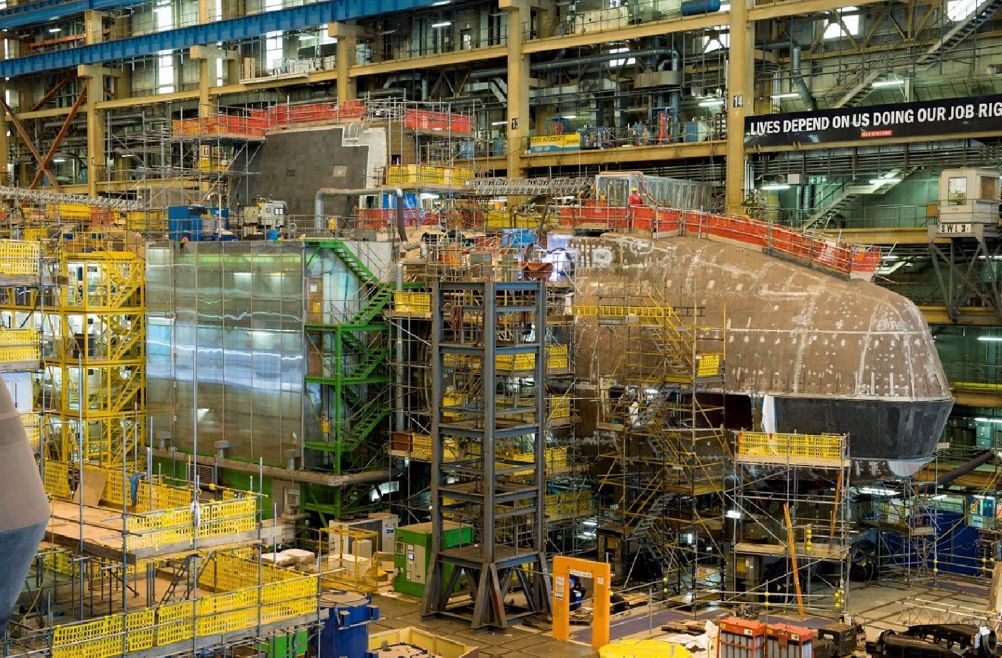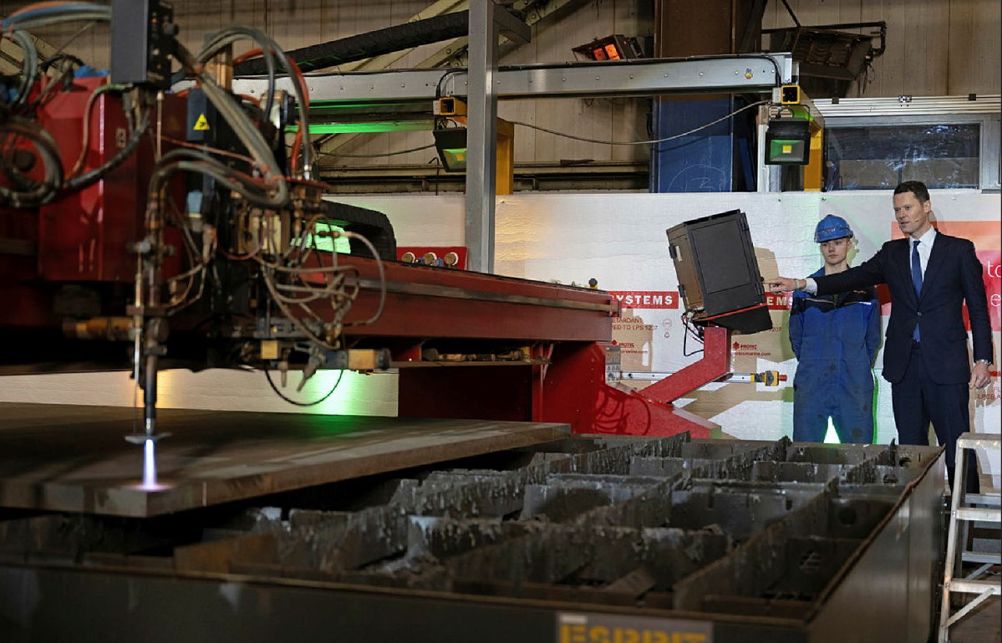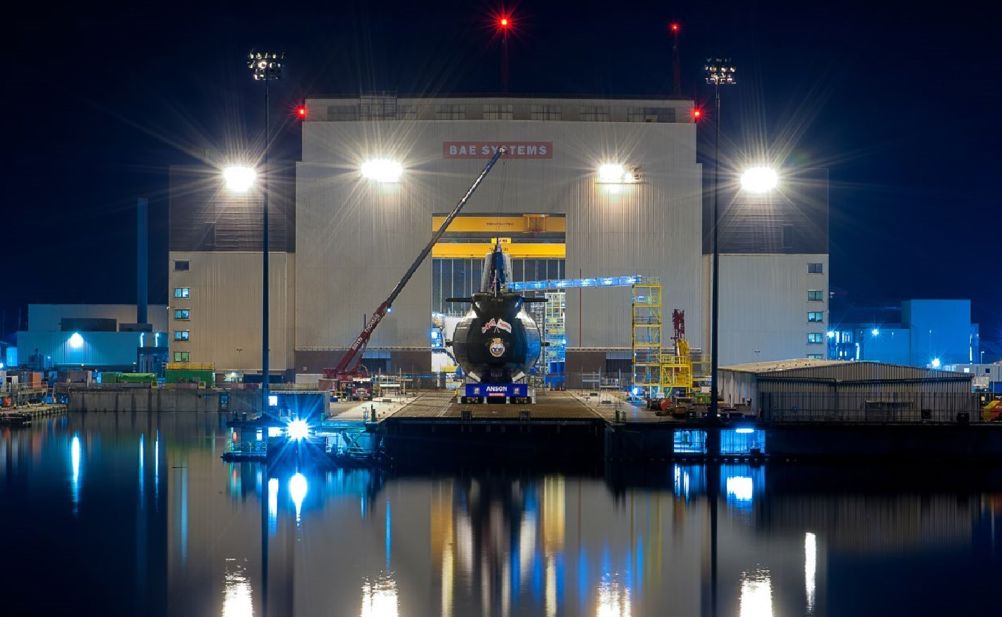On February 9th 2023, the first steel for HMS Warspite was cut at BAE Systems’ shipyard at Barrow-in-Furness, Cumbria. The event coincided with a notional midway point in the build of Warspite’s sister vessel, Dreadnought, the lead submarine in the programme to maintain the UK’s Trident nuclear deterrent. As the third of four new nuclear subs that will make up the Dreadnought Class, Warspite’s initiation came seven years after Dreadnought’s first steel in 2016, and a ballpark, seven-ish years from when Dreadnought will enter service in the ‘early 2030s’. Warspite herself is unlikely to see service until around 2040.
It’s the type of mind-boggling project timeline rarely seen outside of the defence industry, replete with matching price tag. Latest estimates for the cost of the Dreadnought programme are £31bn, alongside a £10bn contingency fund. The two QE class aircraft carriers, by comparison, came in at a paltry £7.6bn for the pair. Like the carriers, Dreadnought represents an enormous feat of homegrown UK engineering. It is one of the most complex build projects the UK has ever undertaken – estimated to account for more than 150 million work hours over the course of the design and construction of the four submarines: Dreadnought, Valiant, Warspite and King George VI.
“Today is an important step in the ongoing delivery of the Continuous at Sea Deterrent (CASD),” Rear Admiral Donald Doull, the Royal Navy’s project lead on Dreadnought, said at Warspite’s steel-cutting event. “It is a key milestone for the programme’s mission to replace the current Vanguard Class submarines with four Dreadnought Class submarines, enabling their successful entry into service.”
As the Rear Admiral was delivering those words, the world was preparing to mark the one-year anniversary of Russia’s invasion of Ukraine. Arguments have been made over the years that the UK’s CASD – running around the clock since 1969 under the banner of Operation Relentless – is an outdated and overpriced boondoggle, a relic of Cold War paranoia. But while the premise of mutually assured destruction is certainly not without its flaws, you don’t have to be Dr Strangelove to find some solace in a UK nuclear deterrent, particularly as Putin wages war in Europe. With no end to that conflict in sight, Barrow-in-Furness has perhaps never been more important to the UK’s strategic defences.

The Dreadnought programme – initially known as ‘Successor’ before the lead vessel was named in October 2016 – underwent its initial assessment phase in 2011, with approval granted for the purchase of long-lead components including steel for the hulls. By that stage, the four Vanguard Class submarines (built by previous custodians of the Barrow shipyard, Vickers Shipbuilding and Engineering, subsequently absorbed by BAE) were approaching the end of their planned service.
Built between 1986 and 1999, the Vanguard nuclear powered ballistic missile submarines (SSBNs, as per US Naval classification) became the UK’s sole nuclear weapons capability in 1998 upon the retirement of the RAF’s WE.177 bomb. The Vanguard Class will continue to operate into the 2030s, pushing well beyond the submarines’ original intended service to maintain the UK’s CASD while Dreadnought comes of age.
Though Vanguard’s four subs will ultimately be replaced by four from the Dreadnought Class, this was not always a given. Labour Prime Ministers Blair and Brown - while both maintaining support for Trident - each considered scaling back the size of Vanguard’s replacement from four submarines to three. At approximately £8bn per vessel – more than both QE aircraft carriers together - it’s certainly a debate worth having. However, Conservative governments later argued that four submarines would be required in order to fully support Operation Relentless and maintain the UK’s CASD 24/7.
Where aircraft carriers are sometimes framed as projecting visible military might, nuclear subs play almost the opposite role, hidden from view for most of their lives, providing an unspoken, ever-present stealth capability
So what does £8bn get you these days when you’re in the market for a nuclear powered ballistic missile submarine? Needless to say, the MOD, BAE Systems and Rolls Royce – who together make up the Dreadnought Alliance - are relatively tight-lipped on engineering detail. All major defence programmes carry a degree of secrecy, but the nature of SSBNs brings the absolute highest levels, for obvious reasons. Where aircraft carriers are sometimes framed as projecting visible military might, nuclear subs play almost the opposite role, hidden from view for most of their lives, providing an unspoken, ever-present stealth capability. The Royal Navy’s Submarine Service is often referred to as the ‘Silent Service’. Unsurprisingly, that silence extends to journalistic enquiries as well as the deep-sea operation of the vessels themselves.
What we do know is that each vessel in the Dreadnought Class will be 153.6 metres in length, fractionally longer than Vanguard’s 149.9m, but significantly shorter than the US’s upcoming Columbia Class of SSBN, which will clock in at 171m. Nonetheless, the Dreadnought Class will be the largest submarines ever built for the Royal Navy, with a displacement of 17,200 tonnes. Each vessel will house 42.5km of piping, along with approximately 20,000 cables stretching to over 347km, as well as around 13,000 individual ‘electrical items’.

At sea, Dreadnought will accommodate 130 crew members, including three chefs and a doctor. The crew will have access to modern gym facilities onboard including exercise bikes, rowers, weights benches and a running machine, and will benefit from an advanced lighting system capable of simulating night and day – a first for a Royal Navy submarine. They will also be the first subs in the Royal Navy fleet with separate quarters, toilets and washing facilities for female crew members.
The vessels will be powered by Rolls-Royce’s latest submarine pressurised water reactor, the PWR3. Rolls-Royce’s partnership with the Royal Navy on nuclear subs dates back to the Valiant Class, commissioned in the mid-1960s. Since then, from the initial PWR1 through to the PWR2, the company’s reactors have powered every Royal Navy nuclear submarine. This includes both the SSBNs that carry Trident as well as the smaller SSN attack submarines such as the Astute Class, which is currently being delivered by BAE Systems at the Barrow shipyard in parallel to the Dreadnought programme.
As far back as 2012, Rolls-Royce was awarded a contract by the MOD to supply the PWR3 for the Dreadnought Class. According to the company, the reactor has 30 per cent fewer parts than the PWR2. Despite this, the engineering bill of material for PWR3 is still around 86,000 lines - more than four times that of a large Trent engine. Based at Rolls-Royce’s spiritual home in Derby, the company’s Submarines division employs more than 4,000 people. This includes around 1,500 engineers, some of whom provide support at the Barrow shipyard as well as the naval bases at Devonport and Faslane.
In March 2023, it was announced that Rolls-Royce will provide the PWR3 for Australia’s nuclear powered submarines as part of the AUKUS trilateral agreement between the UK, US and Australia. The UK and Australia are currently working together on SSN-AUKUS, the attack submarines that will replace the Astute Class and Collins’ Class in the respective countries. While Australia will build its own at its Osborne Naval Shipyard, the UK subs will be the next major project taken up at Barrow. Currently nearing design completion, the first UK boats are due to enter service in the late 2030s.
“We are delighted to be asked to play our part in delivering this element of the AUKUS Agreement and are well prepared to support through our nuclear expertise and engineering excellence,” Steve Carlier, president of Rolls-Royce Submarines, said in March.
“For over 60 years we have provided the power to the Royal Navy’s nuclear submarines and we are proud to be playing a critical role in helping Australia acquire their own nuclear propulsion submarine capability. This is great news for Rolls-Royce and for the country as a whole with the creation of more UK jobs and an opportunity to showcase British innovation and expertise on the world stage.”
While Rolls-Royce and BAE Systems are understandably taciturn on most details around the various submarine programmes, one area where they are forthcoming is on the jobs created and wider economic impact. A 2021 report from BAE claimed that Dreadnought supported almost 30,000 jobs across the UK, with nearly half in the North West of England. Of those, nearly 8,000 are directly employed by BAE itself, with 11,800 jobs in the programme’s supply chain and a further 10,200 induced jobs supported across the country. Over the entirety of the Dreadnought programme, BAE estimates it will spend in the region of £7.5 billion with 1,500 supply chain companies based across England, Scotland, Wales and Northern Ireland.

Of the deals we know about to date, major ones include Thales receiving a £330m contract to provide its Sonar 2076 platform and combat system mast for the four submarines. Announced in February 2020, it’s claimed that deal alone will maintain 520 jobs across Thales’ UK locations, including Templecombe, Cheadle Heath, Crawley and Glasgow. Several contracts have also been awarded in relation to the common missile compartment (CMC) that will house the Trident missiles on both the Dreadnought and Columbia SSBNs. Developed in partnership with the US, the CMC project is a roll call of leading defence companies on both sides of the Atlantic, including General Dynamics, Lockheed Martin, Babcock International and Northrop Grumman. But even given this important international element, BAE Systems estimates that over 90 per cent of Dreadnought-related work will occur in the UK.
“The Dreadnought programme is delivering critical sovereign defence capability that is fundamental to our national security and makes an important contribution to the country’s economic prosperity,” said Steve Timms, managing director of BAE Systems Submarines and a 40-year veteran of the company who joined British Aerospace as a 16-year-old apprentice. “This is a once-in-a-generation opportunity to boost education, infrastructure and technology, to enhance the UK’s maritime supply chain and sustain one of our most critical defence capabilities.
“It will sustain thousands of jobs and generate billions of pounds of investment into the middle of the next decade, benefiting every region of the UK. Barrow may be the birthplace of the UK’s submarines, but the programme is truly a national endeavour that we, the suppliers who help deliver the programme and the whole country, should be proud of.”
A national endeavour it may be, but Barrow is very much the epicentre. Approximately 10,000 people work at the site across both the Dreadnought and Astute programmes, many of them inside the vast Devonshire Dock Hall (DDH) that dominates the local skyline and can be seen from across the mouth of Morecombe Bay in Blackpool. Originally built between 1982 and 1986 when Vickers oversaw the shipyard, DDH sits on land that was previously a part of the dock itself, infilled with 2.4 million tonnes of sand from nearby Roosecote.
DDH provides an indoor working area of around 25,000 square metres, protecting submarines from both the elements and satellite observation. Outside the hall a 24,300-tonne capacity shiplift allows completed vessels to be lowered into the water rather than via a slipway. DDH is also at the centre of a £1bn upgrade and expansion at Barrow that commenced in 2014 in preparation for Dreadnought getting underway.
BAE’s presence in Barrow is clearly enormous, both literally and figuratively. Mammoth structures house an army of designers, engineers, steelworkers, electricians, apprentices and project managers, busying away across multiple giant nuclear submarines. The company is the primary local employer, vital not only to Barrow itself but to the entire North West economy. Across its more than 150 years, the shipyard has employed multiple generations of families, many of whom speak with pride of the work that is carried out there.
The symbiosis between shipyard and town doesn’t sit well with everyone, however, particularly those that oppose Trident and see the shadow of the military industrial complex cast large across Barrow. Any place with such singular reliance on an employer or an industry is exposed to some degree, albeit Trident and Britain’s nuclear submarine fleet appears to be here for the long haul. When Margaret Thatcher was campaigning for her second term as PM, the local slogan used in Barrow was ‘Trident means jobs’. Deep into the Dreadnought programme, it’s a slogan that still carries plenty of weight in the North West today.





Poll: Should the UK’s railways be renationalised?
I think that a network inclusive of the vehicles on it would make sense. However it remains to be seen if there is any plan for it to be for the...